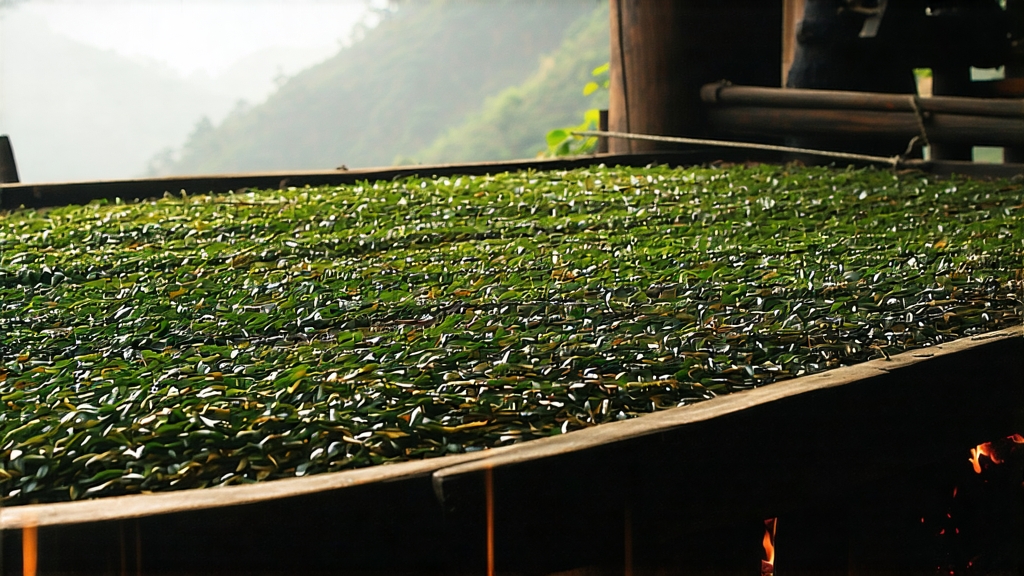
Long before English merchants coined the term “black tea,” the mountain villages of northern Fujian were already fashioning a leaf so bold and fragrant that it would sail across oceans and ignite a continent’s thirst. That leaf is Lapsang Souchong—today celebrated as the earliest black tea ever created, yet still handcrafted in the same mist-wrapped folds of the Wuyi massif where its story began during the late Ming dynasty. To understand why its perfume of pine and longan can transport a drinker to a Chinese charcoal hearth, one must follow the tea from myth to mouth, from camellia grove to glass.
Origin stories differ, but the most oft-told begins around 1646, when Qing troops pressed into the Wuyi region. Villagers, hurrying to dry freshly picked leaves before the soldiers arrived, dried them over hastily built pine fires. The resulting smoky leaf—initially deemed a failure—was sold anyway to passing Dutch traders who, enchanted by its campfire aroma, spread it across Europe. By the early eighteenth century Lapsang Souchong had become the first Chinese black tea to reach London, where it was christened “Bohea” (a corruption of “Wuyi”) and priced higher than green tea. Its success inspired the British to transplant tea plants to India, birthing an entire industry. Thus, every sip of Assam or Ceylon can trace its lineage back to this pine-scented pioneer.
Strictly speaking, only leaf plucked within the 600–1,200 m core of Tongmu Village and its three tiny hamlets—Mashu, Guadun, and Miaowan—may be called Zheng Shan Xiao Zhong, “Original Mountain Small Variety.” Outside that micro-zone the same cultivar and technique yield Waishan Xiao Zhong, a cousin rather than a twin. Within Tongmu, two ecotypes dominate: the small-leaf Cai Cha, prized for sweetness, and the larger Ye Cha, which carries smoke with regal authority. Spring buds arrive in late April, two weeks later than lower-elevation gardens, allowing amino acids to concentrate while spring mountain mist filters ultraviolet light, softening astringency.
Craft begins the moment two leaves and a bud are snapped off the bush. Sha Qing—“killing the green”—is skipped; instead, the leaves are withered across second-floor bamboo racks suspended above crackling pine embers. For twelve to eighteen hours the tea maker balances heat, humidity, and timing: too hot and the leaf chars, too cool and the enzymatic oxidation stalls. When the edges turn chestnut and the midrib remains springy, the leaves are rolled—first by machine, then by hand—to rupture cells and release catechins. Oxidation follows in cedar-lined trays, where the leaf reddens from mahogany to ebony while absorbing ambient smoke. Finally, the tea is baked three times over lower-temperature fires fueled by the resinous heartwood of Masson pines native to the region. Each firing lasts only minutes, but the cumulative effect fixes the signature tarry sweetness that connoisseurs liken to single-malt whisky.
Traditional Lapsang is smoked; unsmoked versions, called Wu Zhong or Zheng Shan Xiao Zhong “Original,” have become popular since the 2000s. To create the unsmoked style, the same leaf is withered using gentle warm air, oxidized, then baked over charcoal made from local hardwoods but without fresh pine needles. The cup turns honey-gold, tasting of dried longan, rose petal, and mineral rock—Wuyi’s “yan yun” or cliff rhyme—yet lacks campfire. Both styles share a velvet body, low astringency, and a lingering coolness that the Chinese call gan: a menthol-like return that blooms minutes after swallowing.
Water is the silent ingredient. Wuyi artisans insist on mountain spring water whose hardness hovers around 50 ppm—soft enough to let volatile phenols dance, yet mineral enough to flatter cocoa notes. For the smoked version, a porcelain gaiwan or thin-walled clay pot from Yixing (duan ni clay) is ideal; the clay’s porosity tames tarry edges while amplifying malt. Measure 4 g of leaf for 120 ml water, cooled to 90 °C. Rinse once, discard, then steep 5